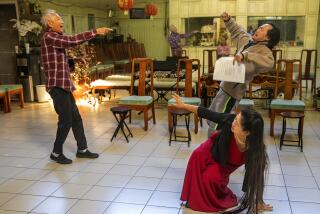DANCE DRAMA : SECOND PROGRAM BY KITA NOH THEATER
- Share via
In Noh drama, the most powerful emotions can be conveyed by the most minimal means.
In the second program presented by the Kita Noh Theater and Nomura Kyogen companies at the Japan America Theatre on Tuesday, a mere bend in the body or a stare straight ahead communicated overwhelming loss in one case and existential futility in the other.
By holding a simple, Pieta-like position for what seemed like an endless, transfigured moment, actor Anshin Uchida focused the enormous emotional forces in Part II of the dance-drama “Tomoe.”
The story recounts how a warrior woman’s love for her defeated lord survived even her death, bringing her back to his shrine.
Through severely economical gestures, such as bending over the lord’s imagined body or slowly raising a hand to his own masked face, Uchida transformed Tomoe from a heroic warrior--who at one point was seen vigorously triumphing over enemies--to a subdued, grieving, restless spirit unnaturally attached to this world.
As portrayed by Uchida, the bond seemed eternal, unbreakable.
In “Kurozuka,” actor Sadayo Kita portrayed a demon disguised as an old woman. Again, such minimal means as motionless staring could convey deep emotion--in this case, the woman’s realization of her profoundly empty life.
The insight occurs when she sits at a spinning wheel and, horrified, withdraws her hand from the wheel in an effort to disengage from life. But the wheel spins on.
Or at least it was supposed to. Kita apparently could not see clearly through his mask and was not able to make the wheel spin “magically.” (He also hit and tilted one of the four wooden columns when leaving the stage.)
Still, his immense powers of concentration and control were abundantly evident elsewhere, particularly in a fight scene with Buddhist monks.
In both works, the drama was enhanced by the deep, resonant chanting of the chorus and by sharp flute and drum accents.
Also on the program were two Shimai dances--the weightless “Hagoromo” danced by the incomparable Arata Kasai and the aggressive “Sessho Seki” danced by Kyoichi Kaneko. The previously reviewed “Yasematsu” completed the program.
More to Read
The biggest entertainment stories
Get our big stories about Hollywood, film, television, music, arts, culture and more right in your inbox as soon as they publish.
You may occasionally receive promotional content from the Los Angeles Times.










